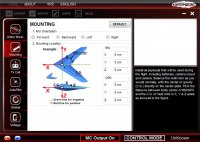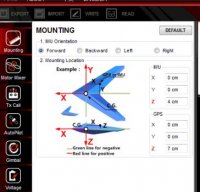Blacksails
Member
I'm flying a droidworx AD8 HLE with av200 and an all up flying weight of around 5.5 - 6kg
I've been flying for some time now with basic gains at 140-150% and the atitude gains set to around 130-140. I noticed that people have said there are major problems with the wkm in wind when flown on bigger ships. I found this odd, as my craft has been coping very well with wind (no erratic twitching, with good GPS hold etc).
I never really bothered too much with the IMU Z axis cog setting. I left it at 0cm and its been flying beautifully, but today I decided to set it as accurately as I could to try and improve even more on my copter. I figured that the Z axis cog is around 7-8cm below the IMU, inbetween the camera and the frame. I found this by hanging the copter from a string on a motor and following the line to the cross section, as well as simply balancing it on my finger tips from the landing gear.
The interesting thing is that with my IMU Z axis set correctly the bird is very VERY twitchy. Even the slightest disturbance and she'll start wobbling and over correcting like mad. Adjusting the basic and attitude gains imporved this but it just will not fly as well as it used to with the Z axis incorrectly set at 0cm. I set it back to its old paramaters and she flys beautifully again in to 10-12mph winds we have today.
Just thought i'd mention this for those people who have set everything up correctly but are still having problems with any kind of wind causing instability.
I've been flying for some time now with basic gains at 140-150% and the atitude gains set to around 130-140. I noticed that people have said there are major problems with the wkm in wind when flown on bigger ships. I found this odd, as my craft has been coping very well with wind (no erratic twitching, with good GPS hold etc).
I never really bothered too much with the IMU Z axis cog setting. I left it at 0cm and its been flying beautifully, but today I decided to set it as accurately as I could to try and improve even more on my copter. I figured that the Z axis cog is around 7-8cm below the IMU, inbetween the camera and the frame. I found this by hanging the copter from a string on a motor and following the line to the cross section, as well as simply balancing it on my finger tips from the landing gear.
The interesting thing is that with my IMU Z axis set correctly the bird is very VERY twitchy. Even the slightest disturbance and she'll start wobbling and over correcting like mad. Adjusting the basic and attitude gains imporved this but it just will not fly as well as it used to with the Z axis incorrectly set at 0cm. I set it back to its old paramaters and she flys beautifully again in to 10-12mph winds we have today.
Just thought i'd mention this for those people who have set everything up correctly but are still having problems with any kind of wind causing instability.



